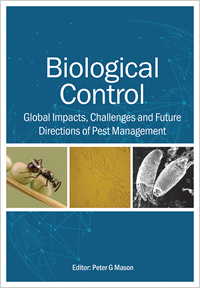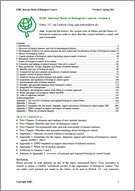Publications
IOBC Global Newsletter
The Newsletter is the main way to provide information to all of our members (and also non-members) all over the world. The information provided within the Newsletter can be used by everyone providing that a clear acknowledgement to the IOBC is made.
Activities and events within IOBC Regional Sections may be of interest to your colleagues outside the Sections as well. They will most probably not be informed if you do not tell them.
You may share information by sending any kind of news to the Secretary General.
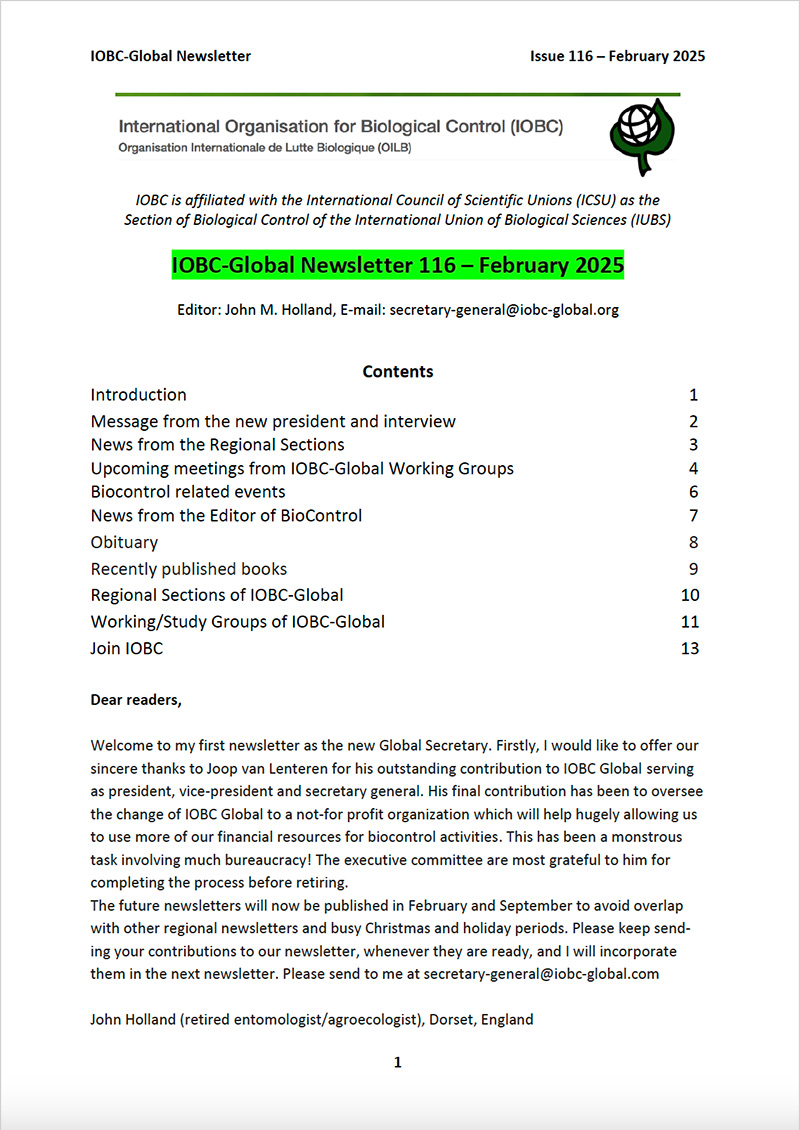 Current Issue:
Current Issue:
Issue 116, February 2025 (pdf)
Contents:
- Introduction
- Message from the new president and interview
- News from the Regional Sections
- Upcoming meetings from IOBC-Global Working Groups
- Biocontrol related events
- News from the Editor of BioControl
- Obituary
- Recently published books
- Regional Sections of IOBC-Global
- Working/Study Groups of IOBC-Global
- Join IOBC
Download the Newsletter, Issue 116 (pdf) and enjoy reading!
The future newsletters will be published in February and September. Please keep sending your contributions to our newsletter, whenever they are ready to: secretary-general@iobc-global.org
Newsletters of Regional Sections
-
West Palearctic Regional Section (WPRS): https://iobc-wprs.org/news.
Subscribe to the free e-mail newsletter, and get the IOBC-WPRS news delivered to your inbox! -
Nearctic Regional Section (NRS): IOBC-NRS Newsletter
-
Asia and the Pacific Regional Section (APRS): IOBC-APRS Newsletter
XVI International Symposium on Biological Control of Weeds (ISBCW), 2023: Proceedings
 The XVI ISBCW was organised in 11 scientific sessions, with 75 oral presentations and 100 posters by 156 participants from 19 countries and 64 institutions from all over the world.
The XVI ISBCW was organised in 11 scientific sessions, with 75 oral presentations and 100 posters by 156 participants from 19 countries and 64 institutions from all over the world.
Download: Proceedings 16th ISBCW 2023 (pdf)
Cabrera Walsh G., Anderson F.E., Mc Kay F., Sosa A.J. and Hernández M.C., eds., 2023. Proceedings of the XVI International Symposium on Biological Control of Weeds. Puerto Iguazú, Argentina, 7 – 12 May 2023, 216 pp., ISBN 978-631-90256-0-6
BioControl
BioControl is the official journal of the International organisation for Biological Control (IOBC) (www.springer.com/life+sci/entomology/journal/10526) and presents original papers on basic and applied research in all aspects of biological control of invertebrate, vertebrate and weed pests, and plant diseases.
 Over the years, it has established a leading role in publishing the finest and most exciting work on all aspects of biological control of invertebrate, vertebrate and weed pests, and plant diseases.
Over the years, it has established a leading role in publishing the finest and most exciting work on all aspects of biological control of invertebrate, vertebrate and weed pests, and plant diseases.
Coverage includes biology and ecology of organisms for biological control, and aspects of use including biological controls for integrated pest management, such as plant resistance, pheromones and intercropping. Papers presenting only laboratory trials on non-target effects of pesticides on natural enemies are not considered but papers dealing with the corresponding effects on community dynamics of natural enemies are welcomed.
Great reasons for publishing in BioControl:
- Impact Factor: 2.2 (2023)
- 5-Year Impact Factor: 2.9 (2023)
- Downloads: 214,349 (2023)
- Submission to first decision (Median): 5 days
Online submission at www.editorialmanager.com/bico
Books
Control Biológico en América Latina y el Caribe: Su rica historia y futuro brillante
(Spanish version of Biological Control in Latin America and the Caribbean: Its Rich History and Bright Future)
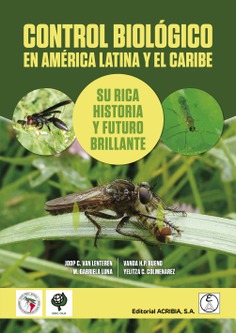 Editado por: Joop C van Lenteren, Universidad de Wageningen, Países Bajos, Vanda H P Bueno, Universidad de Lavras, Brasil, María Gabriela Luna, Universidad Nacional de La Plata, Argentina, Yelitza C Colmenarez, CABI, Brasil.
Editado por: Joop C van Lenteren, Universidad de Wageningen, Países Bajos, Vanda H P Bueno, Universidad de Lavras, Brasil, María Gabriela Luna, Universidad Nacional de La Plata, Argentina, Yelitza C Colmenarez, CABI, Brasil.
Publisher: Acribia S.A., Zaragoza, Spain
Price of printed book and ebook 42 Euro (+ shipping costs).
Order the book directly at the publisher: https://www.editorialacribia.com/libro/control-biologico-en-america-latina-y-el-caribe_130523.
Pocas publicaciones han proporcionado detalles históricos sobre el control biológico de plagas, malezas y enferme- dades en América Latina y el Caribe, y los datos han es- tado fragmentados hasta ahora. Al reunir esta importante información en este libro, se ofrece una visión completa de los avances significativos en control biológico en el Continente suramericano e islas del Caribe. Para cada país, se proporciona una gran cantidad de texto, tablas y referencias sobre la historia de dichos proyectos. Con detalles sobre los éxitos y fracasos, lo cual puede ayudar en la planificación de futuros proyectos de control biológico. El libro proporciona una descripción general de las prácticas actuales de control biológico, revelando un alto nivel de utilización, lo que convierte a la región en la mayor área tratada con control biológico a nivel mundial. En conclusión, el libro describe nuevos desar- rollos y especula sobre el futuro del control biológico en América Latina y el Caribe.
Contenido clave:
- Resumen completo y documentado del control biológico en América Latina y el Caribe, junto con registros de plagas invasoras y nativas.
- Ejemplos únicos de control biológico por conservación, control biológico natural, con- trol biológico clásico y control biológico aumentativo.
- Treinta capítulos específicos de países redactados por especialistas nacionales.
- Revela muchos casos de control biológico desconocidos internacionalmente y su in- vestigación histórica.
- El primer intento serio de estimar cultivos y áreas bajo diferentes tipos de biocontrol.
Adecuado para estudiantes y profesionales que trabajan en el campo del control biológico, manejo de plagas, biología de invasiones, ecología y comportamiento, MIP y agricultura sus- tentable.
Biological Control in Latin America and the Caribbean: Its Rich History and Bright Future
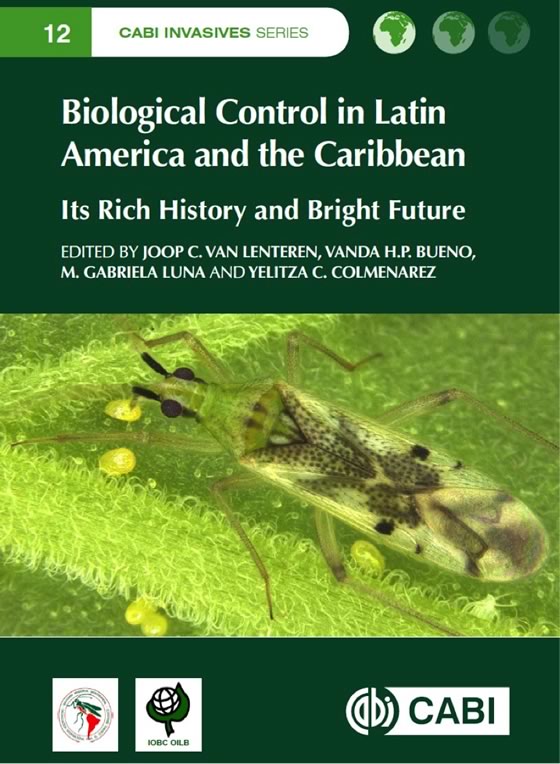 Edited by: Joop C. van Lenteren (Laboratory of Entomology, Wageningen University, The Netherlands), Vanda H.P. Bueno (Laboratory of Biological Control, Federal University of Lavras, Brazil), M. Gabriela Luna (Universidad Nacional de La Plata, Argentina), and Yelitza C. Colmenarez (CABI Brazil, Botucatu, Brazil)
Edited by: Joop C. van Lenteren (Laboratory of Entomology, Wageningen University, The Netherlands), Vanda H.P. Bueno (Laboratory of Biological Control, Federal University of Lavras, Brazil), M. Gabriela Luna (Universidad Nacional de La Plata, Argentina), and Yelitza C. Colmenarez (CABI Brazil, Botucatu, Brazil)
December 2019, 550 pages, ISBN 9781789242430
Written mainly by IOBC-NTRS authors.
The book summarizes the history of biocontrol in Latin America. Few publications provide historical detail and the records are, therefore, fragmented until now. By bringing information together in this book, a complete picture of important developments in biological control on this continent is provided. There are a wealth of text, tables and references about the history of projects, and which were successful and which failed. This will help plan future biocontrol projects. An overview is provided of the current situation in biocontrol for many countries, revealing an astonishing level of practical biocontrol applied in the region, making it the largest area under biocontrol worldwide. The final part describes new developments and speculates about the future of biocontrol in Latin America and the Caribbean.
Information about ordering the book: https://www.cabi.org/bookshop/book/9781789242430
Biological Control: Global Impacts, Challenges and Future Directions of Pest Management
October 2021 (hardback), 664 pages, ISBN: 9781486309344
Hard copies of the book will be available from CSIRO (Australia and New Zealand; https://www.publish.csiro.au/book/7821) and CRC Press (all other countries; https://www.routledge.com/Biological-Control-A-Global- Endeavour/Mason/p/book/9781032109275). The eBook version will be available from more than 30 eRetailers, such as Amazon, Kobo, Google Books and eBooks.com.
The book provides a historical summary of organisms and main strategies used in biological control, as well as the key challenges confronting biological control in the 21st century. Biological control has been implemented for millennia, initially practised by growers moving beneficial species from one local area to another. Today, biological control has evolved into a formal science that provides ecosystem services to protect the environment and the resources used by humanity. With contributions from dedicated scientists and practitioners from around the world, this comprehensive book highlights important successes, failures and challenges in biological control efforts. It advocates that biological control must be viewed as a global endeavour and provides suggestions to move practices forward in a changing world. Biological Control is an invaluable resource for conservation specialists, pest management practitioners and those who research invasive species, as well as students studying pest management science.
More information and contents of the book: https://www.publish.csiro.au/book/7821
Area-Wide Integrated Pest Management - Development and Field Application
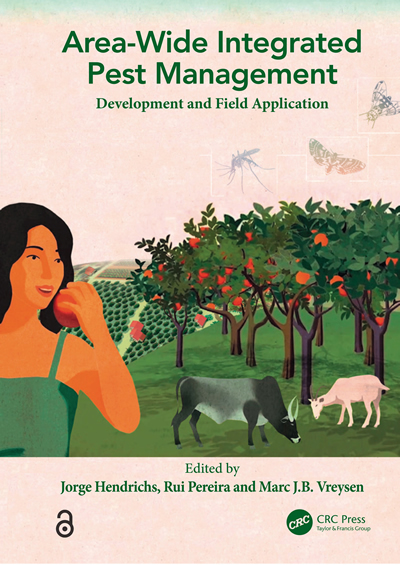 Edited by: Jorge Hendrichs, Rui Pereira, Marc J.B. Vreysen
Edited by: Jorge Hendrichs, Rui Pereira, Marc J.B. Vreysen
1st Edition, first published 2020, eBook published 1 January 2021
Several IOBC members participated in writing chapters of this book.
Over 98% of sprayed insecticides and 95% of herbicides reach a destination other than their target species, including non-target species, air, water and soil. The extensive reliance on insecticide use reduces biodiversity, contributes to pollinator decline, destroys habitat, and threatens endangered species. This book offers a more effective application of the Integrated Pest Management (IPM) approach, on an area-wide (AW) or population-wide (AW-IPM) basis, which aims at the management of the total population of a pest, involving a coordinated effort over often larger areas. For major livestock pests, vectors of human diseases and pests of high-value crops with low pest tolerance, there are compelling economic reasons for participating in AW-IPM.
The book is essential reading for the academic and applied research community as well as national and regional government plant and human/animal health authorities with responsibility for protecting plant and human/animal health.
Open Access, eBook or Download: DOI, https://doi.org/10.1201/9781003169239
Integrative Biological Control Ecostacking for Enhanced Ecosystem Services
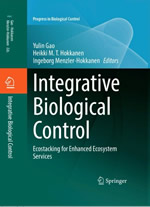 Edited by: Yulin Gao, Heikki M. T. Hokkanen and Ingeborg Menzler-Hokkanen. April 2020, 248 pages, ISBN 978-3-030-44837-0
Edited by: Yulin Gao, Heikki M. T. Hokkanen and Ingeborg Menzler-Hokkanen. April 2020, 248 pages, ISBN 978-3-030-44837-0
This book is the first to integrate biological control into a conceptual framework – ecostacking - uniting all aspects of biological control and ecosystem services. In 2018 the "First International Congress of Biological Control" was organised and held in Beijing, China. The chapters highlight some of the achievements presented at the congress, worldwide. Of particular significance are the numerous contributions by Chinese researchers illustrating the remarkable progress made on developing and adopting multiple biological control strategies over vast agricultural areas, largely replacing chemical pesticides for sustainable agricultural and horticultural production. In many parts of the world including Europe, fragmented research based on short-term funding has been unable to answer to the needs to develop sustainable long-term solutions to crop protection, while colleagues in China have been successful in implementing programs that exemplify the power of the ecostacking approach. Key contributions by European and US specialists combined with the expertise and experiences by the Chinese contributors comprise the building blocks for the integration of biological control approaches into the overall frame of ecostacking. This book will lead the way to a broader, integrated adoption of biological control techniques in sustainable pest, disease and weed management supporting also the functioning of other key ecosystem services.
Chapter 2 of this book is available open.
Information about ordering the book: https://www.springer.com/us/book/9783030448370
The Use and Regulation of Microbial Pesticides in Representative Jurisdictions Worldwide
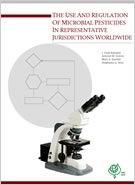 Edited by: Kabaluk, J. Todd, Antonet M. Svircev, Mark. S. Goettel, and Stephanie G. Woo, 2010. IOBC Global. 99pp.
Edited by: Kabaluk, J. Todd, Antonet M. Svircev, Mark. S. Goettel, and Stephanie G. Woo, 2010. IOBC Global. 99pp.
When there is potential for harm to human and environmental health from the introduction of a pest control product, regulatory procedures for pre-market assessment of safety are common in most countries. An effective regulatory framework provides protection from harm, while still facilitating the availability of useful products. It recognizes the needs of farmers, society, and the commercial interests of the pest control product proponents i.e. registrants. The latter are recognized by being provided clear communication of the terms of the regulatory system and the stepwise process of product registration, and by being charged reasonable costs for registration so products move seamlessly from the application for registration through to the market.
The presentation of the regulatory systems in the following chapters provides a means to compare and contrast the variety of approaches taken by selected jurisdictions (countries or groups of countries) in establishing a framework that offers protection from harm, while offering pest control products with utility for farmers, and their degree of success in doing so.
More information: Table of contents and link to download pdf
Quality Control and Production of Biological Control Agents
 Edited by: Joop C. van Lenteren, Department of Entomology, Wageningen University, The Netherlands
Edited by: Joop C. van Lenteren, Department of Entomology, Wageningen University, The Netherlands
This book was written by many IOBC members and is the result of work done in global and wprs working groups on quality control of natural enemies. The use of biological control agents has been increasing worldwide and there are now many companies massproducing such organisms, particularly for the control of insect pests. However, there is a great need for quality control in the production and use of these natural enemies, which include insect parasitoids and predators, fungi and viruses. This book has been written by leading scientists to provide both background theory and practical guidance on this subject.
ISBN 0 85199 688 4, hardback, 327 pp., US $ 120.00, https://bookshop.cabi.org (some copies still available for reduced price at Joop.vanLenteren@wur.nl)
IOBC Internet Book of Biological Control – Version 6, February 2012
New in version 6:
New Chapter: Evaluation and ranking of new natural enemies
New Chapter: Benefits and costs of biological control
New Chapter: Environmental risks and risk assessment of natural enemies
New Chapter: Mistakes and misunderstandings about biological control
Appendix 2: Glossary of terms related to biological control
Appendix 3: Guidelines for the export, shipment, import and release of biological control agents (ISPM 3, 2005)
Appendix 4: EPPO standard on import and release of natural enemies
Appendix 5: White list of natural enemies
Additions to Chapter 3 and 4
Aditions to Appendix 1: overview of national and regional biological control book
More information: Table of contents and link to download pdf
International Organisation for Biological Control: History of the First 50 Years (1956-2006)
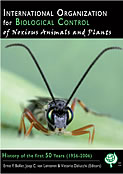 Boller, E.F., J.C. van Lenteren and V. Delucchi (eds.), IOBC, Zürich, 287 pp.
Boller, E.F., J.C. van Lenteren and V. Delucchi (eds.), IOBC, Zürich, 287 pp.
The IOBC promotes the development of biological control and its application in integrated plant protection and production programmes. IOBC coordinates biological control activities worldwide in six Regional Sections and in Working Groups. This book describes the origin and development of the organisation, and summarizes its current actvities.
Download: IOBC, History of the First 50 Years (1956-2006) (pdf)
Share Information
Please share your information by sending any kind of news to the IOBC Secretary General
IOBC-Global Newsletter
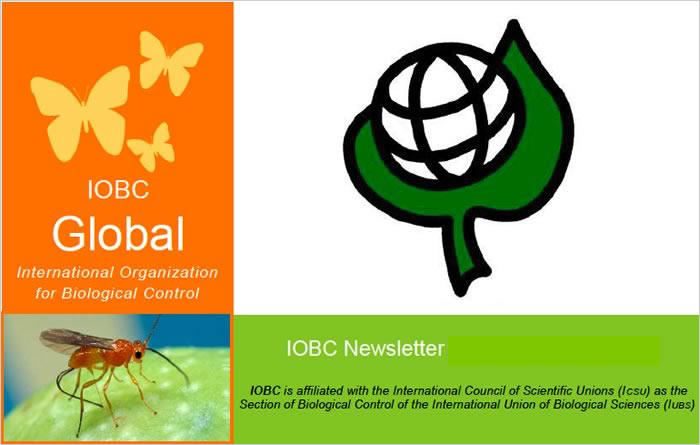
Archives:
- 116, February 2025
- 115, July 2024
- 114, December 2023
- 113, August 2022
- 112, December 2022
- 111, August 2022
- 110, Dec. 2021 - Jan. 2022
- 109, July 2021
- 108 bis, March 2021
- 108, Dec. 2020 - Jan. 2021
- 107, June-July 2020
- 106, December 2019
- 105, June 2019
- 104, Dec. 2018 - Jan. 2019
- 103, June 2018
- 102, December 2017
- 101, June 2017
- 100, December 2016
- 99, June 2016
- 98, December 2015
- 97, June 2015
- 96, December 2014
- 95, June 2014
- 94, December 2013
- 93, June 2013
- 92, December 2012
- 91, June 2012
- 90, December 2011
- 89, Aug. 2011
- 88, December 2010
- 87, June 2010
- 86, December 2009
- 85, April 2009
- 84, October 2008
- 83, March 2008
- 82, October 2007
- 81, March 2007
- 80, October 2006
- 79, March 2006
- 78, October 2005
- 77, April 2005
- 76, December 2004
- 75, October 2004
- 74, July 2004
- 73, Summer 2001
- 72, Winter 2000 - 2001
- 71, Summer 2000
- 70, Winter 1999
- 69, Summer 1999
- 68, Winter 1998
- 67, Summer 1998
- 66, Winter 1997
- 65, Summer 1997
- 64, November 1996
- 63, April 1996
- 62, November 1995
- 61, April 1995
- 60, October 1994
- 59, March 1994
- 58, October 1993
- 57, March 1993
- 56, August 1992
- 55, April 1992
- 54, December 1991
- 53, August 1991
- 52, April 1991
- 51, December 1990
- 50, August 1990
- 49, April 1990
- 48, December 1989
- 47, August 1989
- 46, April 1989
- 45, December 1988
- 44, August 1988
- 43, April 1988
- 42, December 1987
- 41, August 1987
- 40, April 1987
- 39, December 1986
- 38, August 1986
- 37, April 1986
- 36, December 1985
- 35, August 1985
- 34, April 1985
- 33, December 1985
- 31-32, March 1984
- 29-30, November 1983
- 27-28, April 1983
- 25-26, November 1982
- 23-24, June 1982
- 21-22, November 1981
- 19-20, March 1981
- 17-18, October 1980
- 16, July 1980
- 15, March 1980
- 13-14, 1979
- 11-12, 1979
- 10, 1978
- 9, 1977
- 8, April 1976
- 7, January 1976
- 6, August 1975
- 5, April 1975
- 4, October 1974
- 3, April 1974
- 2, November 1972
- 1, March 1972
